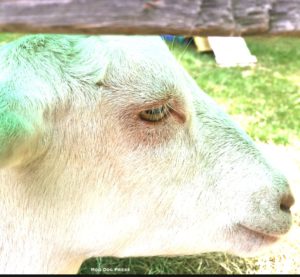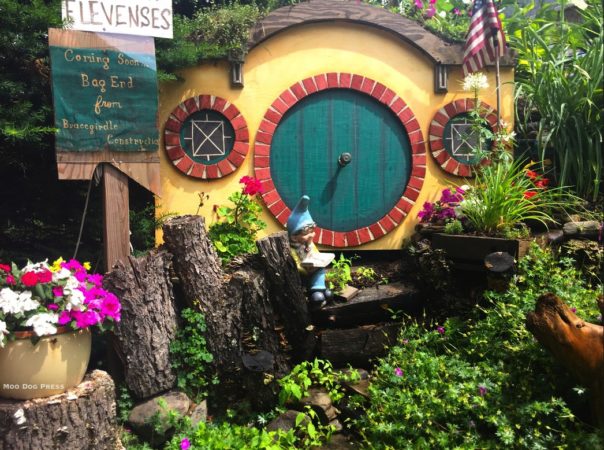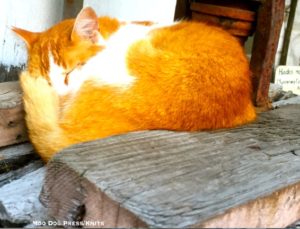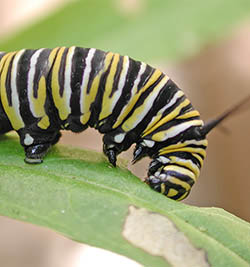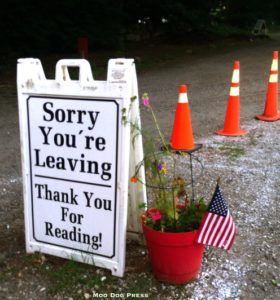Garden + Books: Oasis Of The Book Barn (Main Barn) Niantic = Magic
Gardens and books; books and flowers.
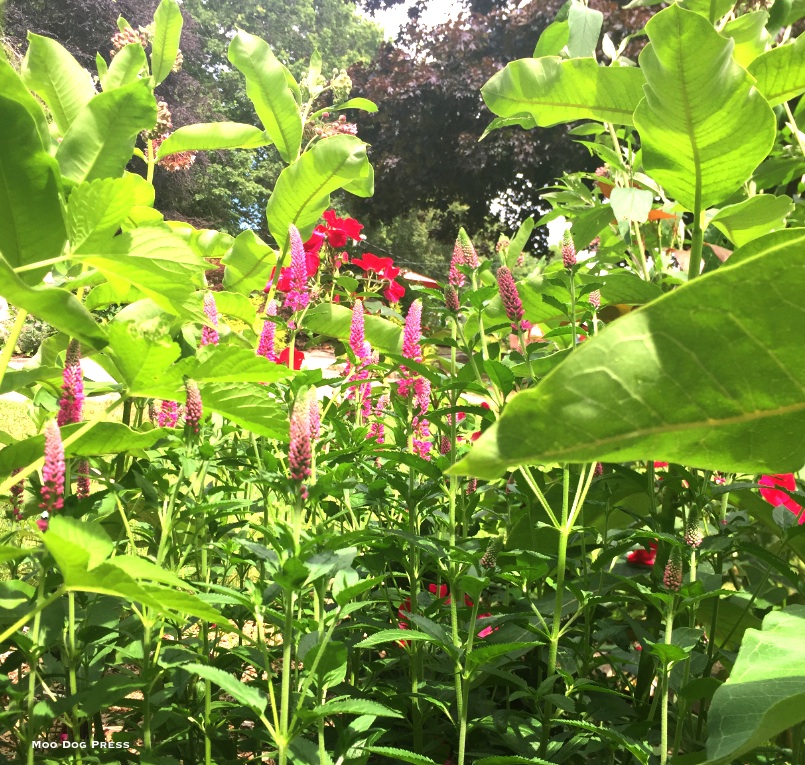
Colorful torches of blooms in the gardens that grow behind The Book Barn, Main Barn, Niantic, Connecticut.
Butterflies, bees, caterpillars, assorted unidentified insects flock to the flowers and plants. Hidden delights that await the curious – turtles, flowing water, gargoyles, even a re-creation of Bag End, a beloved Hobbit residence may be found on site. Wry bits of information posted to guide the way, providing humorous and intelligent tongue-in-cheek commentary for visitors. An airy barn and outbuildings full of books neatly shelved; two friendly goats and a number of resident cats.
This is an oasis for readers and lovers of words – The Book Barn, Main Barn, Niantic. Three other locations – Midtown, Downtown, and Store Four – offer even more reading potential and all are located within a few minutes drive. Tolerance and intelligence grow here, too. A garden full of books, a bookstore fringed with gardens. To attract pollinators, cultivate a garden of plants for their food and lives; to entice readers, offer books – sorted by subject or mixed together as new arrivals.
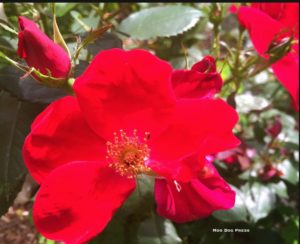 “Across the millennia, an author is speaking, clearly and silently, inside your head, directly to you. Writing is perhaps the greatest of human inventions, binding together people, citizens of distant epochs, who never knew one another. Books break the shackles of time – proof that humans can work magic.” — Carl Sagan
“Across the millennia, an author is speaking, clearly and silently, inside your head, directly to you. Writing is perhaps the greatest of human inventions, binding together people, citizens of distant epochs, who never knew one another. Books break the shackles of time – proof that humans can work magic.” — Carl Sagan
Magic, indeed. The Book Barn's Main Barn in Niantic is one of four sites where books – some estimate 350,000 to 500,000 of them – await readers. But it is the Main Barn which features well-tended gardens bursting with blooms that attract pollinators and readers alike. The staff here know and love books. This is a slice of paradise.
Here then is the backstory of the humans who care and cultivate the gardens which attract a spectrum of life.
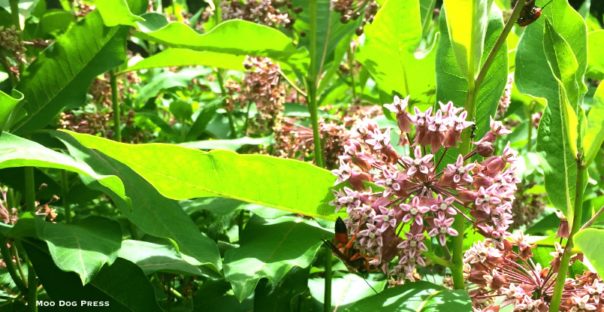
Another world – beneficial insects are attracted to the exquisite blooms of a milkweed at The Book Barn.
“I began the gardens when my daughter was young, as a hands-on approach to teaching her about nature, and the world that I had so enjoyed growing up with,” wrote Maureen “Mo” White, who grew up as 10th of 11 children in Uncasville, Connecticut. (Maureen is married to Randi White; the two are owners – and growers – of the Book Barn since 1988.) “We lived most days in the woods, and helped with the small family farm that my parents had developed on their property. At different times we raised chickens, cows, ducks, geese, rabbits, pigs, goats, lambs, and had a large vegetable garden for canning and freezing. At one time, my dad also had beehives in our backyard.
“When Randi and I moved into this house, my daughter, Jennifer, and I would go exploring around the property. We found cicada exoskeletons stuck onto some trees, and they were pretty amazing to a 3 year old! It was pretty sobering when I realized how few insects that I grew up with were available to show my daughter. She was very interested in learning about butterflies and walking sticks, praying mantis, and grasshoppers. As we began learning about these bugs, she became particularly interested in Monarch butterflies, and we read everything we could find on them. It did not take us long to discover that the Monarch butterfly is becoming challenged and is almost endangered. We researched what we could do to help mitigate the deforestation of the pine forests in Mexico and California where the Monarchs spend their winters and then migrate to Connecticut. We found that the main food source for the Monarch, and in fact, the place where a Monarch can achieve their full life cycle is on the common milkweed plant.
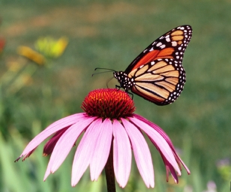
Monarch on purple cone flower. Photo: Steven Katovich, USDA Forest Service. Linked to more information at UConn Extension Bug Week.
“As they migrate northward, Monarchs will find milkweed, lay their eggs on the underside of the leaves. When the eggs hatch, the pupae will eat the egg casing, and then eat the milkweed leaves. They are voracious eaters, and will continue munching the leaves until they are large enough to hang upside down from a leaf, form themselves into a letter J and then slowly turn into a chrysalis, where they will remain zippered up until it turns transparent, and the zipper line opens and the new Monarch emerges. While their wings are still wet, they will sit on a leaf or branch opening and closing their wings until they have fanned themselves sufficiently dry and go on their first test flight. An amazing sight to see midsummer! I remembered blowing the milkweed seed thistle as a favorite childhood pastime in the cow pasture when I helped my dad feed the cows and bring them to water in the evenings. One of the first Book Barn gardens was planted as a ‘Monarch Helper Garden' to assist their resurgence in our part of Connecticut.
“The photo of Randi and I with our staff (seen here) does not include my two trusty garden helpers, David Heath and Kris Hazel. They have been an enormous help to me over the past 3 years, and they are truly instrumental in the continuation and future development of the Book Barn gardens.”
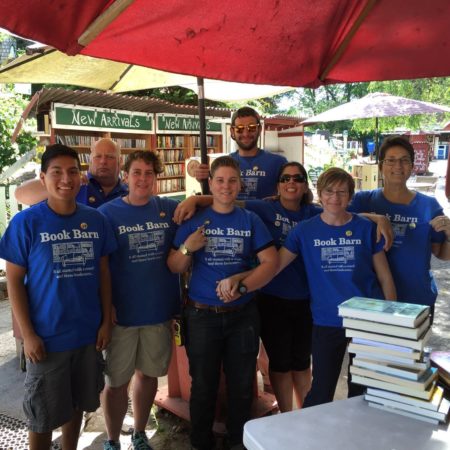
Randi White (back left with collared shirt) with (left to right) Adam Howard, Laurie McGuinness, PJ Brackett, Angelo Granell, Julie Wooten and Maureen White – The Book Barn, Main Barn, Niantic, Connecticut. Images linked to their Facebook page for news and happenings.
“Let's see, other plant varieties I have in the butterfly and surrounding gardens include bee balm, daisies, lavender, roses, scabiosas, coreopsis, fennel, cosmos, speedwell, cleomes, a variety of lilies and hostas, coneflowers, black-eyed Susans, zinnias and some other herbs.
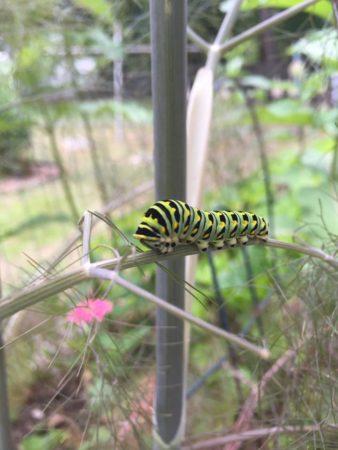
“We have swallowtail caterpillars on our fennel – Yay!” – a photo and post from The Book Barn's Facebook page and linked there for readers.
“I chose these particular plants because they are, as you noticed, very attractive to pollinators. We have had in recent years, a steady decline in honey bees, bats and other helpful creatures. I am trying to establish an area in our little part of the world that can assist Mother Nature recreate a balance where things have fallen short, and help maintain a natural balance when and where I can. Most of the plants here attract several species of animals and insects each. Lots of different bees and butterflies, moths, hummingbirds, finches, etc. While the flowers attract bees, so do the buds and blossoms of my fruits and veggies. And the few strawberry plants in my back yard really have become brunch for the oversized chipmunk family that have taken up residence there! I have become more aware of the local, indigenous plants and am trying to increase their numbers here as well. Most of the plants here were chosen to be helpful, but there are a good number of them that have been given to me, or traded for one plant or another. Some are from friends and family, while others came from customers. We like to share knowledge with each other.
“What I usually suggest to beginner gardeners is to not be afraid of trying! Pick an area with lots of sun, an average of 6 hours a day for a full sun garden. The easiest plants to begin with are annuals, and they are fast growers, with lots of colorful blooms so you achieve instant success. I enjoy mixing in some herbs here and there so your weeding job smells great every time you brush up against some sweet basil or oregano. And don't get me started on the amazing fragrances of lavender and rosemary! Ask your nursery person for suggestions for the best fit for your area. Water regularly, apply a good fertilizer and mulch well. Remember that annuals enjoy being trimmed, so they also make for a perfect cutting garden.”
Note: Should you need any more encouragement, there is a whole section on gardening and nature writing at The Book Barn, Main Barn, Niantic. Open every day, 9 a.m. to 9 p.m. For information on Bug Week, featuring hands-on activities for the whole family – including learning about pollinators – see our Let's Go Ag • Events page.
Read more

